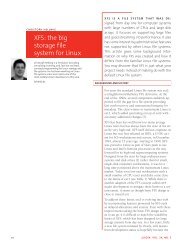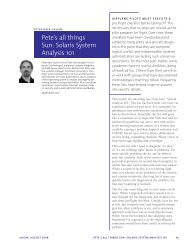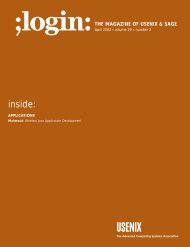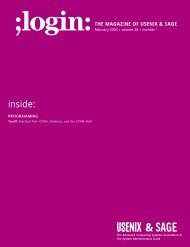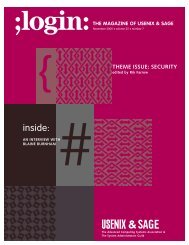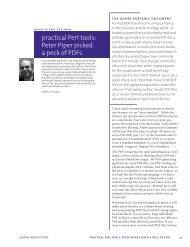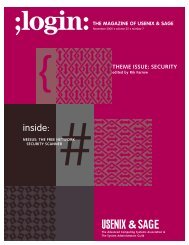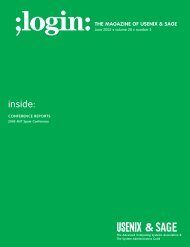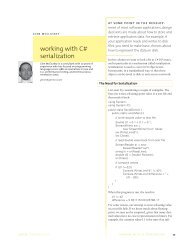inside: Focus Issue: Security
inside: Focus Issue: Security
inside: Focus Issue: Security
You also want an ePaper? Increase the reach of your titles
YUMPU automatically turns print PDFs into web optimized ePapers that Google loves.
NO PLAINTEXT PASSWORDS/STRONG AUTHENTICATIONThe other vector for attack is via a compromised account where the password for thataccount had been sniffed from the network, or guessed. Additionally, many intruderswill install a sniffer, regardless of their main purpose, to opportunistically find otheraccounts and machines to compromise.A compromised account is one of the most difficult to detect. How can one easilydetermine whether a given login session is the legitimate user or an intruder?We use a combination of solutions to provide authenticated services where passwordsare either encrypted or not transmitted (e.g., SSH, Kerberos). 9PracticesREFERENCE SYSTEMSThe general process of creating a reference system is to first install an appropriateselection of system software (usually, the vendor’s procedures will be used for this),then add SDSC-specific software (e.g., cfengine), then modify everything to fix securityproblems and establish the functionality we require. Key to making this work is ahigh degree of automation, which allows the easy replication of the system. 10Our reference system includes the following:■ Automated configuration management using cfengine (see description, below).■ Time synchronized to atomic clocks using Network Time Protocol. This is essentialwhen mounting a central NFS file system. Synchronized time is also useful forforensic purposes in analyzing file timestamps and correlating syslog entries frommultiple hosts.■ Centralized account management. NFS requires that UIDs be consistent acrossclients in order to prevent inadvertent access to protected files. Centralizedaccount management keeps UIDs consistent across all our machines.■ A password-changing program that rejects easy-to-guess passwords. Our passwordchanging uses cracklib 11 to test passwords that could be guessed with crack,instead of trying to crack them after the fact. Why look for crackable passwordswhen you can prevent people from using them in the first place?■ Detailed logging to a central host. All syslog facilities are forwarded to a centralloghost and archived on our storage system (yes, we have eight years of logsstored!). Centralized logging preserves log data in the event that a system is compromisedand local copies of the logs are modified by the intruder. Centralizedlogging also allows us to monitor logs for interesting activity across all hosts.■ Most services (including RPC) protected by TCP Wrappers. Some services whichshould only be used within our networks are limited to just those networks. TCPWrappers also provides consistent logging of accepted and refused connectionsfor services, even those accessible from anywhere.■ SSH. 12■ Kerberos 5 authentication for Telnet, FTP, rlogin, & SSH. 13■ Email notices sent to administrators at shutdown and boot time. Getting bootand shutdown notices helps alert us to potential problems with a host. It alsoreminds us to check hosts that have been down for a period of time and ensurethat they are fully patched.■ Sudo. 14 Most users who need privileged access are given it via sudo. Very few peopleactually have the root passwords. Sudo assists with accountability by logging9. See Abe Singer, “No Plaintext Passwords,”;login:, November 2001, vol. 26, no. 7, for detailsof how we eliminated plaintext passwords.http://www.usenix.org/publications/login/2001-11/.10. Jeff Makey wrote this in an unpublisheddocument describing our reference system.11. Cracklib, http://www.crypticide.org/users/alecm.12. See Singer, “No Plaintext Passwords.”13. See Singer, “No Plaintext Passwords.”14. Sudo, http://www.courtesan.com/sudo.● SECURITYDecember 2003 ;login:LIFE WITHOUT FIREWALLS ●39



